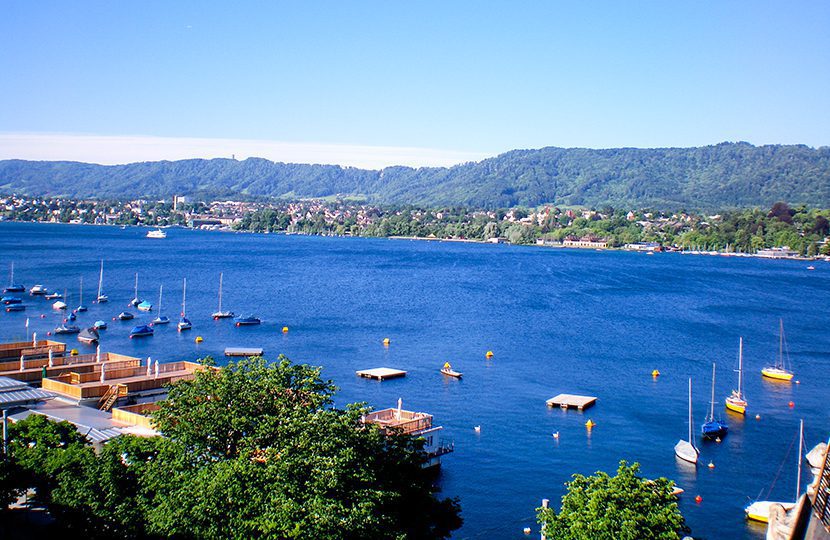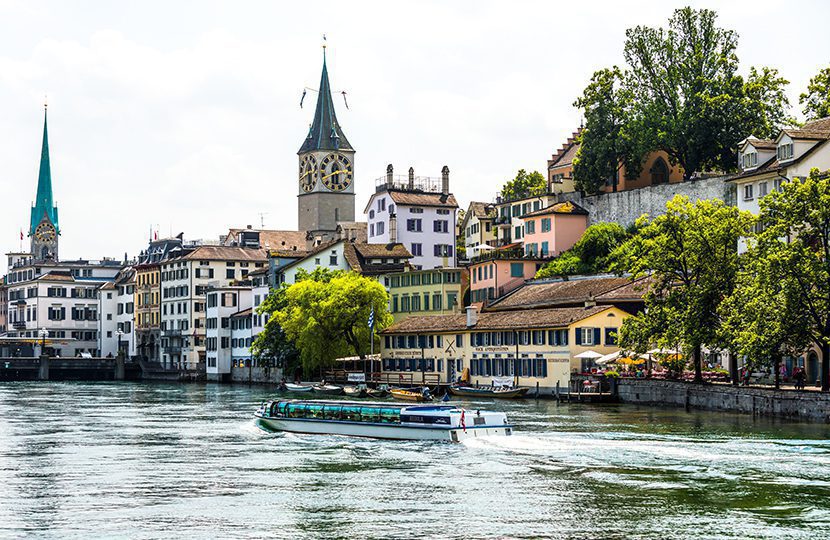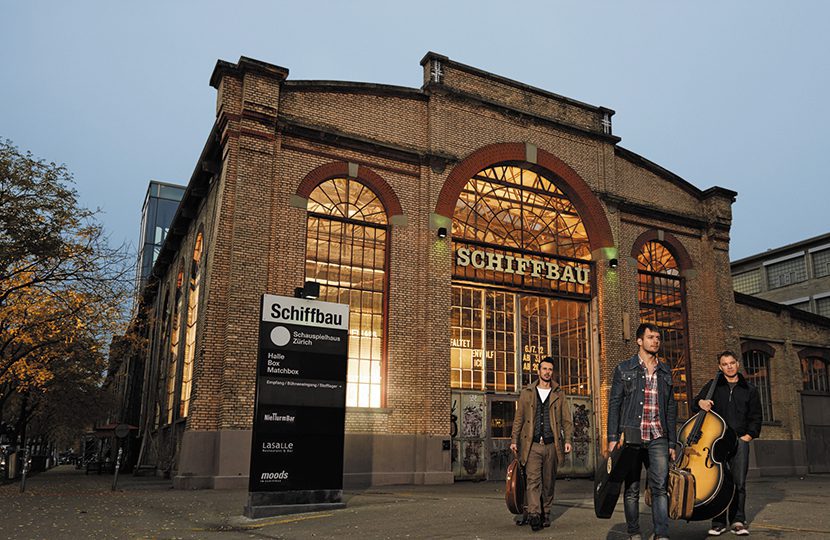[vc_row][vc_column][vc_column_text]
Switzerland has been in the news for decades thanks to international conferences, natural beauty, and celebrity residents, yet like so many of the famous people who call the country home, it remains a nation superficially familiar to many but well known by few.
[/vc_column_text][/vc_column][/vc_row][vc_row][vc_column width=”1/4″][vc_separator color=”black” border_width=”10″][vc_custom_heading text=”Switzerland”][vc_separator color=”black” border_width=”2″][vc_widget_sidebar sidebar_id=”sidebar-page”][/vc_column][vc_column width=”3/4″][vc_column_text][vc_row][vc_column][vc_column_text]
Switzerland has been in the news for decades thanks to international conferences, natural beauty, and celebrity residents, yet like so many of the famous people who call the country home, it remains a nation superficially familiar to many but well known by few. This is especially true of Zurich, the country’s largest city.
Zurich is undergoing a startling transformation as one of Europe’s most vibrant cities. Just ask Corine Mauch, Zurich’s mayor who has led the city since 2009. Shirking the introspection of past generations, today’s young Swiss are worldly, cosmopolitan citizens who value their good luck in living in a city with a quality of life annually ranked as the highest in the world.
Then again, Zurich has always been at the forefront of the good life. From its time in the 16th century when the silk industry made the city rich thanks to the quality of textiles produced here, Zurich has seen its fortunes rise over the centuries. It remains one of the most important financial centres in the world, but, not unlike the current experience of Singapore, a telephoto focus on money has widened to a panoramic understanding that happy lives and financial prudence are not mutually exclusive.
- The Limmat River with St Peter Church clocktower
Best Of Old Zurich
Unsurprising given the amount of wealth in the country, Zurich’s major museums are endowed with impressive collections, however unsung they may be on the international arts scene. The Zurich Kunsthaus is a splendid repository of Swiss and international art; virtually unknown outside the country, the works of artists Ferdinand Hodler and Giovanni Segantini are unique reflections of Swiss culture, more fully evident in the vast collections of the newly refurbished Landesmuseum (Swiss National Museum), the country’s foremost institution of Swiss history. Displays at the evocative Museum Rietberg stimulate nearly as much excitement as the displays of chocolates, cakes, and pastries in the windows of Sprüngli’s flagship boutique on Bahnhofstrasse, Zurich’s famous shopping street.
In a country renowned for its hospitality and hotel schools, it comes as no surprise that Zurich’s hotel scene is peppered with several outstanding properties where well-heeled guests feel at home. The sumptuous Dolder Grand opened its doors in 1899, but time had not been kind to this landmark property on a hill above Zurich. With great fanfare and a revamp by no less a starchitect than Sir Norman Foster, The Dolder was reborn several years ago as a deluxe spa resort with style and grace to match its privileged setting.
Renovation work started from the bottom, literally. The earth around the base of the existing building was removed, leaving the hotel resembling an island floating on a sea of air. A billion dollars later, the landscapes curve gracefully around the restored original building and Foster’s Spa and Garden Wings. The Dolder offers a type of casual luxury popular with young Europeans cashed up from their business ventures; suits, ties and gowns are far outnumbered by polo shirts in a range of pastels.
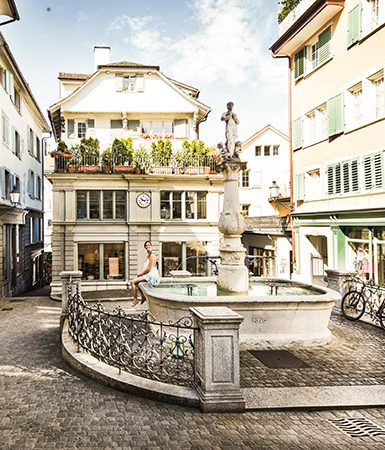
Zurich’s many picturesque little squares
Widder Hotel is Zurich’s best-kept open secret. This remarkable property exudes a type of class and sophistication appealing to business travellers, design mavens, and affluent shoppers. Stylish interiors by Swiss designer Tilla Teus characterise the hotel’s charming blend of traditional architecture and contemporary design. Widder is not a single building but rather an aggregate of nine historic houses in the centre of Zurich’s atmospheric Old Town. Every room at Widder is unique, some showcasing the original architectural details such as exposed beams, impressive frescoes, and decorative stencils while others are thoroughly contemporary in style, with Modernist furniture and expansive spaces culminating in the stunning penthouse suite which has a private rooftop terrace for taking in the cityscape in total privacy.
More formal than Widder, Baur au Lac is the accommodation of choice for heads of stateand other dignitaries who come to Zurich on official business. For leisure visitors whose business is being immersed in luxurious surroundings while being attended to by staff who know guests’ names before they even arrive, Baur au Lac makes an equally outstanding option. The hotel sits at the end of Bahnhofstrasse, where the world’s most coveted luxury goods (especially watches) can be found along with the charming Schweizer Heimatwerk handicraft shop which showcases the best of Swiss-made souvenirs.
Occupying a large, private park on the edge of Lake Zurich already sets the hotel apart from others in the city. Needless to say, the rooms and suites at Baur au Lac are spacious and smartly decorated in an array of styles to give returning guests a different experience each time they stay, though many often want the same room every time. Baur au Lac’s lobby lounge is the hotel’s living room, a relaxed place to enjoy a morning newspaper, a catch-up with friends, or a drink from the bar. A must-try is the Swisstini, the hotel’s signature drink made to look like the Swiss flag.
Follow this taste sensation with lunch or dinner at Pavillon, Baur au Lac’s exceptionally refined Michelin-starred restaurant. Head concierge Jérémie Varry and his attentive team know no limit to ensuring guests’ needs are met and exceeded. From private shopping experiences to special arrangements for marriage proposals, the word ‘no’ does not exist here. Airport and railway transfers can be arranged in the hotel’s Rolls-Royce Phantom; Baur au Lac has an exclusive arrangement with Zurich Airport’s VIP Services division to provide the most private and expedient arrivals and departures.
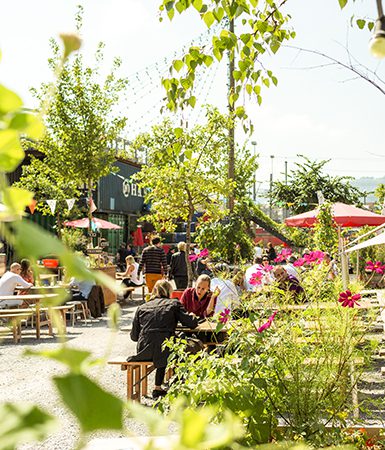
The Swiss love the outdoors in both summer and winter
Zurich West, The New Zurich
For someone who has been to Zurich before and remained within the confines of the Old Town and its immediate vicinity, staying in Zurich West can be a revelation. The Toni Areal complex is the heart of this formerly unfashionable area which pumps the lifeblood that has brought a pulse back to an industrial nexus now revived as cultural spaces with an attitude; that attitude is decidedly young, confident, and progressive in thinking thanks in no small part to the Zurich University of the Arts located within the complex. Also part of the complex (and the University) is the impressive Museum für Gestaltung – Schaudepot (Museum of Design at Schaudepot) which opened its doors in September 2014 to serve as a showplace for the temporary exhibits found upstairs, though items on permanent display in the lower storage rooms can be visited on a very interesting tour to see the various collections kept on shelves in a controlled environment.
As is typical of contemporary cultural institutions, the Schaudepot is not merely a place for mere observation but rather a multipurpose art and design centre with a multitude of activities to complement the exhibits. Dance performances, recitals, poetry readings, and even puppet shows crop up on a busy calendar of events. The large, enclosed atrium of the Toni Areal complex serves as the museum’s forecourt and food court at the same time; of course, no decent museum these days is without an artsy café serving coffee and sundry food items. The large communal tables encourage communication while patrons watch the comings and goings of people throughout the day.
One of the most interesting collections in the Schaudepot is related to the graphic arts, a field in which the Swiss have excelled for decades. Helvetica, the world’s most popular font due to its clarity and precision of line, is named after Switzerland itself. Look at the stamps before sending postcards to friends and loved ones; the word Switzerland is nowhere to be found. Instead, there is Helvetia, the Latin name for Switzerland. In a country with four official languages, it was decided that a neutral name was needed in order to be fair to everyone.
The Schaudepot’s travel poster collection is another aspect of graphic arts showcasing Swiss excellence, demonstrating how the use of words, fonts, and colours can influence perceptions of Switzerland and how those perceptions have an effect on the economy.
Several blocks from the Toni Areal complex is the new Kunsthalle Zurich, where the enormous spaces alone are worth seeing. The temporary exhibits presented in them are almost secondary to the repurposing of this impressive complex that is also home to the Migros Museum of Contemporary Art. The Kunsthalle is a venue for temporary exhibits featuring avant-garde artists, though like the Schaudepot there is an active calendar of events taking place here sponsored by both the Kunsthalle and the Migros Museum, whose Generations In The Museum program manifests an acute awareness of the need to overcome generational boundaries by encouraging participants of all age groups to interact with each other, with art as the unifying topic. The Museum’s proactive programs play a useful role in serving the community.
- Schiffbau
A combination entry ticket allows access to both the above museums on Limmatstrasse, home to some unusual art galleries such as Panasia, which specialises in contemporary Vietnamese art, and buzzy restauclubs like Alice Choo. The Mehrspur nightclub and music venue, back in the Toni Areal complex, is open until the early hours of the morning for those who seek nocturnal entertainment. Jazz is popular here, but other kinds of music are also performed.
As elsewhere in the world, eating has been transformed from a private activity undertaken at home with friends and family to a social event without peer. Zurich West’s beautiful Schiffbau building has been converted from an outdated shipbuilding facility to a performing arts centre with an elegant restaurant called Lasalle where reservations for a table are among the most coveted in the city. The repertory company performing on the stages of Schiffbau’s theatres bring to life some classic plays in a decidedly modern locale.
Another revitalization project with laudable results is Im Viadukt, a former train line reincarnated as a series of cafés and boutiques. Regarded by many as the quintessence of Zurich West’s second life, Im Viadukt embodies all that a visitor could wish for. In true alternative spirit, there are fashion boutiques ranging from second-hand clothing shops to the latest in stylish designs; a market hall purveying the finest food products straight from the farm; wine, furniture, homewares, and sound systems for sale in their unerringly (anti)chic retail outlets; and food, dance, music, and even yoga events taking place on a regular basis.
As have other urban renewal projects for disused railways in Paris and New York, Im Viadukt has brought the area back to life, especially in summer. In the warmer months, Zurich West is abuzz with outdoor cafés, bars, and beer gardens. The somewhat insouciant appearance and surroundings of Frau Gerolds Garten and of Zurich West in general, with many walls covered in graffiti, may seem unseemly to visitors accustomed to immaculate urban spaces and public order; to the Swiss, it is this very escape from regulation that makes Zurich West so appealing a place to spend time away from the micromanaged rigours of daily life elsewhere in the city. Im Viadukt’s slogan is “Get Away From It All And Find Balance”. Exactly.
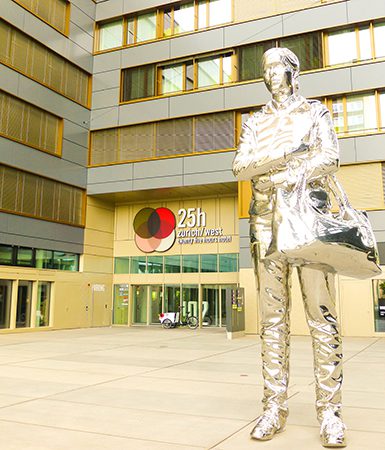
25hours Hotel Zurich West forecourt
It’s not just the buildings that make Zurich West what it is now and what it is becoming; it is the people. This part of the city is definitely the place to witness a new generation of Swiss coming into their own as adults in a world markedly different from that of their parents, who grew up in a neutral country in the centre of Europe but in many ways removed from the continent surrounding it. The young, urban Swiss of today are insatiably curious about life outside their microcosm of comfort and high wages. In a country where breaking the rules is tantamount to high treason, this new generation pushes the boundaries with the result that open minds open more minds. Long recognised for technical prowess and faultless precision, Switzerland is now also gaining recognition as a creative hotbed in the worlds of architecture, furniture design, and fashion, all of which are readily visible on the streets of Zurich West.
The imposing chrome statue in front of 25hours Hotel Zurich West is a perfect example. Located in a modern building constructed for modern living, the trendy 25hours Zurich West, a member of Design Hotels, succeeds in its mission to provide guests with a creative setting for sleeping, working, eating, and socialising according to 21st-century expectations. The busy ground floor of this millennial favourite multitasks as Reception desk, table tennis hall, casual bar, and a restaurant serving food combinations as original as the decor. The check-in counter, staffed by an ultra friendly team of good-looking polyglots, is off to the side, leaving the social scene to take centre stage. The proximity of the University ensures a steady flow of young and talented people having a coffee or a meal at Neni, the 25hours’ food outlet that lets guests enjoy their meals wherever they want in the hotel or out on the patio.
Upon entering the rooms at 25hours, the first things noticed are the colourful carpet, the curves and off-angles of walls and furniture, and the big glass wall letting in lots of light. Concern over city noise disturbing sleep is unfounded; the soundproof windows keep the sounds of urban living out. Once awake after a good night’s sleep, it’s time to grab the Freitag shoulder bag provided for use for the duration of one’s stay and maybe also one of the bicycles available at the front desk to explore Zurich’s coolest neighbourhood carrying Zurich’s coolest bag, created by a Zurich West-based company founded by two brothers who personify the creativity of the entire neighbourhood. Daniel and Markus Freitag were working as graphic designers; they needed to protect their work from rain, wind, and coffee but found nothing suitable, so they did what creative people do and invented the solution to their problem. Now a worldwide phenomenon, Freitag’s bags are locally produced right in Zurich but have transcended the Zurich area to become a must-have fashion accessory for the stylish traveller with an environmental conscience; these bags, made from what Freitag calls F-abric, are based on the same material used for truck covers. They are durable, but they are also biodegradable. Freitag fans can visit the factory in Zurich Noerd just north of Zurich West; individual tours are not offered, but group tours can be arranged after sending a request form and receiving approval from the company.
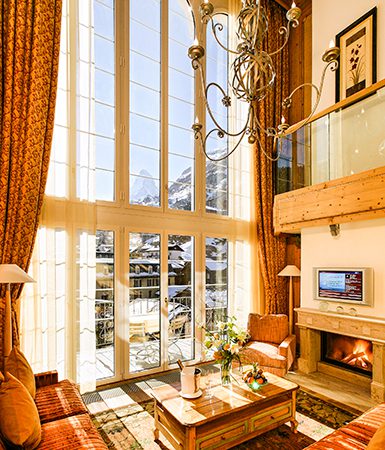
A beautiful suite at Mont Cervin Palace
Zermatt, Another Z Worth A Visit
Attractions beyond the immediate vicinity of 25hours are also easily accessible thanks to the #4 tram that stops at Toni Areal and runs directly to the main railway station, the transport centre of all Switzerland. Some of the trains departing Zurich Hauptbahnhof head to Zermatt, Zurich’s Alpine athletic playground where the ski season in this charming village in the visually spectacular canton of Valais lasts far into late spring, a particularly popular time to visit. Skiers and nonskiers alike enjoy seeing millions of highland flowers in bloom on the mountainsides, colouring the valley with bright hues for a brief moment before the height of summer brings another wave of avid visitors to town for Zermatt’s Swiss Food Festival in the month of August.
The fabled Matterhorn can be credited with putting the Valais region on the map as a travel destination for Europe’s 19th-century leisure classes, especially those from Great Britain. The mountain itself was first conquered by Briton Edward Whymper, who reached the summit in 1865. Word got out about Whymper’s feat and the allure of mountaineering became all the rage among the British elite, to the point that Queen Victoria was compelled to issue an edict forbidding the activity to British subjects lest the younger generation of British wealth and privilege be wiped out by a slip on the ice. Naturally, such a declaration only served to enhance the Matterhorn’s temptation and Zermatt has never looked back.
Read More
[tana_media_list categories=”media-list” count=”5″ item_style=”link_icon” text_light=””]
Zermatt sits at the end of a narrow valley that is seemingly a timewarp of traditional Swiss country life somehow persevering in modern times, adapting the best of contemporary living without sacrificing the past. The rock walls of the valley are primaeval in appearance, rugged and stark just like the buildings. Even the two black horses who live next to the Herbriggen railway station look almost prehistoric in their strong builds and black matte coats, seemingly more like animated charcoal drawings than real horses. The counterbalance to the feeling of living history is Zermatt’s noticeably youthful vibe perpetuated by the many skiers and snowboarders who come to live in the village for a while, complementing the local populace with a cosmopolitanism usually expected only in places many times its size. Like surfers and professors, snow people are a tribe unto themselves and readily share anecdotes and information with their brethren; this gives Zermatt a feeling of community that embraces visitors, who obviously share the same love of winter sports or at least a love of superb scenery. At the same time, there is certainly an elite subset of residents and visitors who prefer the amiable camaraderie of Zermatt to the more formal social scenes of other ski resorts in Switzerland such as Davos and St Moritz.
Whether to see flowers in bloom or snowfields of white, a ride on the Matterhorn-Express cable car is a highlight at any time of year. Rising from Zermatt (1620 metres above sea level) to the Little Matterhorn (3883 metres), the Matterhorn-Express is not only a marvel of engineering but also a traveller’s delight, offering increasingly astounding views of the village as it changes from a life-size human settlement to a speck in a wide Alpine vista. At the top is the Matterhorn Glacier Paradise, a series of corridors within the glacier with artistic ice carvings illuminated to clever effect. Not overwhelming in its displays, the real attraction of Matterhorn Glacier Paradise is simply being inside a glacier. The Matterhorn-Express can arrange a VIP cable car for two people to travel to the mid-level Trockener Steg station in private, with music and champagne as the only other passengers before continuing to a higher altitude if desired.
In a cosy village like Zermatt, it’s nice to have friends. The enthusiastic amiability of Mont Cervin Palace, Zermatt’s top hotel, makes a warm welcome. Beyond the expected rooms, suites, and services are the fun-loving attitude of the staff who follow the example of their ebullient hosts, Simone and André Seiler, in welcoming guests with big smiles and easy laughter. Mont Cervin Palace’s most exclusive wing, the Petit Cervin, is a small annexe connected to the main building; the suites here are even larger and the Michelin-starred Capri restaurant, recognised as one of the best Italian restaurants in Switzerland, even more of a gourmet dining experience.
Zermatt is a car-free village – the only transport in town are electric vehicles and horsedrawn carriages. For the ultimate in rail experiences to arrive from Zurich, Swiss Federal Railways provides the possibility of chartering historic railway carriages for those who wish to see the passing scenery in total privacy and comfort shared only with friends and family, perhaps while enjoying some of Switzerland’s excellent wines. Wineries of the Valais are increasingly on the radar for oenophiles who know Swiss wines are hard to find outside the country due in no small part to the locals buying up almost the entire annual production for themselves. Quite savvy, these Swiss.
Subscribe to the latest edition now by clicking here.
If you would like to comment on this story or anything else you have seen on World Travel Magazine, head over to our Facebook page or message us on Twitter.
And if you liked this story, subscribe to our bi-monthly World Travel Magazine, a handpicked selection of editorial features and stories from Global Destinations, Inspire Me, Insider, Style File, Wellness & Travel, City Travel, Suite Life, At Leisure, Short Breaks and much more.[/vc_column_text][/vc_column][/vc_row]

